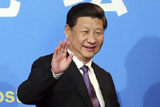China has many trade-deal options
Updated: 2014-03-28 08:41
By Yifan Hu (China Daily Europe)
|
|||||||||||

Beijing needs to secure a strong position in international agreements to grow its economy
The World Trade Organization's 159 members reached a landmark agreement at the end of the last year, a "trade facilitation" deal, which will streamline international customs procedures.
However, despite this far-reaching achievement, the WTO's authority has been sapped by numerous bilateral agreements or initiatives from a closed group of countries.
The United States, for example, led a triple front of negotiations to sign trade agreements with Asia-Pacific countries (Transpacific Partnership, or TPP), Europe (Transatlantic Trade and Investment Partnership, or TTIP), and a group of so-called really-good-friend countries (Trade in Service Agreement, or TISA).
This new wave of preferential trade agreements comes amid persistently weak global trade, exacerbation of trade disputes, frustration with the WTO, and the need to adapt to a multipolar world marked by China's increasing power.
China is now confronted by the threat of trade traffic diversions if the TPP and the European deal materialize. We have seen that the economic impact could be moderately negative for China. However, the long-term impact is much more important as the TPP in particular will contribute to shaping the lines of trade integration in the Asia-Pacific region.
Strategically, China can adopt several positions to deal with the new trade agreements. It can try to join the TPP and allow favorable access to its market as a bargaining tool to integrate it, and thereafter influence the trade agreement's structure from inside.
This is the "inside" strategy. The potential benefits of such an approach have to be put in perspective, with costs linked to an unfavorable trade structure with TPP members, high constraints on intellectual property, state-owned enterprises, financial markets, government procurement and labor market standards.
The "outside" strategy is not exclusive and does not mean non-participation in the TTP.

This strategy, which would target an intensification of trade negotiations in the ASEAN+3's framework, provides more positive effects and better perspectives for shaping the future structure of regional integration in the Asia-Pacific region. This path toward a free trade area of the Asia-Pacific is better suited to the structure of the Chinese economy, and does not exclude a potential collaboration with TPP members or the ability to influence or trade with them.
China has recently expressed its interest in joining the TISA. The creation of the Shanghai Free Trade Zone represents another illustration of its will to endorse principles of trade regulation outside the WTO's framework. An e-commerce platform will be launched in this zone and will allow mainland consumers to buy foreign products with better assurance regarding their authenticity. The transparency of this system and the standards of consumer protection correspond to the TPP approach.
There are therefore an increasing number of signals showing China's willingness and readiness to converge toward international standards of multilateral agreements outside the WTO.
China's inside strategy toward TPP could involve the following tactics: It might join the negotiations and show its willingness to converge toward international standards. It might adopt a long-term lobbying strategy with current members (on a bilateral basis) to integrate and influence the agreement. It might also use the size of its market as a bargaining chip to be accepted into negotiations and later shape the structure of TPP. It might participate in the TPP with a negative list approach, preserving the most strategic sectors of the economy such as electronics and financial activities. It might also pair domestic economic reform with the TPP. The rebalancing of the economy would justify an adapted program of convergence toward TPP standards.
China may also seek access to the US gas market to benefit from lower prices via the TPP, as the US Natural Gas Act limits exports and the TPP should offer privileged access to this source of energy. It might finalize the formation of the FTAAP through joint participation in the TPP and ASEAN+3 initiatives. Another tactic might be to accelerate the establishment of a free trade zone as a pilot program of the TPP and TISA and expand it at an appropriate pace to accumulate experience and better prepare the economy for higher standards of trade and services.
The Shanghai zone, which was officially established on August 22 last year, was viewed as a trial of how China could further open up and push forward reforms, as well as implement a higher standard of international rules on foreign direct investment and trade. Various similar features between the TPP and TISA, and the Shanghai zone, include a negative list approach on market access, extremely low duty on imported goods, liberalized interest rates, an e-commerce platform with customer and intellectual property protection, and an opening up of the capital account.
All of these allow China to better evaluate likely implications of the TPP and TISA for its economy and promote a smoother transition to an economy with a higher degree of openness and consistency with international norms.
The government announced specific policies after the Shanghai zone was established and foreign companies are gradually putting down their roots there. Applications for free trade zones by other local governments - including Tianjin, Guangdong, Zhejiang and Shandong - are currently under scrutiny by the State Council, which is expected to announce the results in May.
Lobbying with TPP members can be fruitful as examination of their positions reveals a persistently high divide. Leaked documents on the current position of partners allow the construction of indexes (+1 for approval of a proposal, 0 for reserved position and -1 for refusal) on the strength (positive value) or weakness (negative values) of the consensus inside the TPP. With regard to the different countries and sectors of negotiations, several significant features are apparent.
The US obviously has the initiative as reflected by the high value of its aggregate index. This agreement therefore has a high US bias. China could use this to convince other TPP members to ask for better representation.
Asian countries, such as Malaysia and Vietnam, are the most opposed to the current arrangement. Their closeness to China (in terms of geography and economic structure) shows that China would struggle to integrate into the TPP. However, China can try to work with these countries to make the agreement converge more toward their economic model.
Intellectual property is the main bone of contention, showing that the US has a low chance of imposing its view in this area.
The TPP has an "aggressive" dimension as mirrored by the high value of the index related to the rules of origin. There is therefore a significant risk of trade diversion for China. This should incite the Chinese government to envisage an adapted strategy, probably with competing trade agreements.
Therefore, developing an "outside strategy" in regard to the TPP is a necessity for China. It would have the following features:
Such a strategy would promote the Regional Comprehensive Economic Partnership, which could boost China's GDP by 0.5 percentage point by 2025, compared to a drop of 0.09 percentage point linked to the TTP's trade traffic diversion. The positive economic impact linked to the promotion of the ASEAN+3 initiative would more than outweigh the negative impact linked to trade traffic diversion following the creation of the TPP.
The ASEAN+3 initiative would be more suited to the structure of the Chinese economy as more similar job markets would lead to the definition of acceptable labor market standards. Standards related to intellectual property would also be closer among ASEAN+3 members.
China could also use the RCEP to gradually increase domestic standards and therefore retain its competitive advantage in its labor market, which is less exclusive and more economically integrative compared to the TPP. The ASEAN+3 area is characterized by a high level of intra-trade, which facilitates economic integration.
Another tactic for China would be to promote the active participation of Japan and South Korea in the RCEP through bilateral arrangements as their participation in only the TPP would be a game-changer in terms of market size. China would still be able to influence the TPP through common members of the ASEAN+3 or bilateral arrangements.
Identifying the strategies of traditional US partners inside the RCEP could help China avoid a hollowing out of the agreement.
Completing the RCEP with the creation of an Asian infrastructure bank, as well as introducing initiatives on food, climate change, disasters, energy, security and safety in the South China Sea could all assist China's cause.
China could also prepare to create an FTAAP with an RCEP-based approach while continuing to be an active member of the WTO. It also has the chance to develop alternative trade platforms, in particular with BRICS countries, when large trade bloc try to impose unacceptable conditions.
China theoretically faces the triple threat of trade traffic diversion, exclusion from negotiations on the future shape of trade in the Asia Pacific region, and a diminishing geo-strategic role in this area. However, the "inside strategy" of progressively integrating the TPP and the "outside strategy" of developing competing agreements represent the best ways to reduce these threats and exploit the flexibility of these new forms of trade cooperation.
Far from being exclusive, the two strategies are complementary as they have the same long-term objectives: the promotion of free trade in the Asia-Pacific, the promotion of structural reforms; adapting the trade partnerships to the Chinese economy and integrating them more throughout the the Asian region.
The author is head of research and chief economist at Haitong International Securities based in Hong Kong. The views do not necessarily reflect those of China Daily.
(China Daily European Weekly 03/28/2014 page13)
Today's Top News
Partnership with Belgium, EU highlighted
Turkish PM wins local elections
Monday's search for MH 370 resumes: AMSA
Families of flight MH370 passengers 'need closure'
Greece passes new reform bill
Dobass demonstrators demand referendum
MH370 relatives demand answers
Turkey starts local elections
Hot Topics
Lunar probe , China growth forecasts, Emission rules get tougher, China seen through 'colored lens', International board,
Editor's Picks

|

|

|

|

|

|





